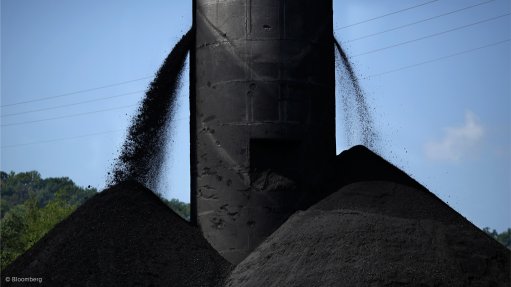
Photo by: Bloomberg
VANCOUVER (miningweekly.com) – US coal companies, emerging from Chapter 11 protection with a smaller footprint and leaner operations, will face significant liabilities for environmental reclamation, according to a new report from Moody’s Investors Service.
In the wake of widespread mine closures amid falling demand, such obligations were much more significant for the ailing coal industry than in the past, and would likely strain companies’ liquidity, cash flows or access to capital, the ratings agency advised.
Dwindling coal demand over the past several years had forced many significant North American coal producers into Chapter 11 reorganisation, and while these companies were expected to emerge smaller and leaner, they would also need to acclimate to the level of diminishing demand for coal production, Moody’s Investors Service advised.
These companies would also inherit significant reclamation liabilities.
“Environmental obligations are emerging as a much more significant issue for the ailing coal industry than in the past. Though the Surface Mining Control and Reclamation Act has existed since 1977, environmental liabilities generally did not put an overwhelming strain on companies’ liquidity, cash flows or access to capital until the industry started to collapse a few years ago,” stated Moody’s VP and senior analyst Anna Zubets-Anderson.
Moody’s advised that, in a healthy and stable industry, reclamation work was expected to be long-dated and comfortably funded by ongoing operations at active mines. Or, if needed, coal companies would generally be able to sell noncore mining operations. But, as the industry underwent a restructuring in the face of a severe demand contraction, and utilities continued to shift to natural gas consumption and away from coal, companies had to shut mines amid drops in output, making reclamation liabilities a more pressing issue.
Regulators also played a role, as producers had to submit reclamation plans with their applications for state permits to mine. Companies also had to post reclamation bonds in the form of surety, collateral or self-bonds that would secure performance under their plans.
The report noted that, for Moody’s-rated companies recently in bankruptcy, the majority of bonding obligations just prior to filing were self-bonds.
“Self-bonding essentially allows the operator to avoid posting asset collateral to secure their reclamation obligation, permitting the company to pledge its assets to other creditors,” says Zubets-Anderson.
However, the report pointed out that the emerging miners would likely have to secure a greater proportion of their bonding requirements by posting collateral, which would put pressure on their liquidity. Even if companies were allowed to continue to self-bond, bonding requirements could become a sudden draw on liquidity and force the operator into bankruptcy at a time of financial distress.
Should a state regulator become concerned with the company’s financial condition, it could request additional collateral to continue its mining permits, which an ailing company might not be able to provide, Moody’s stated.